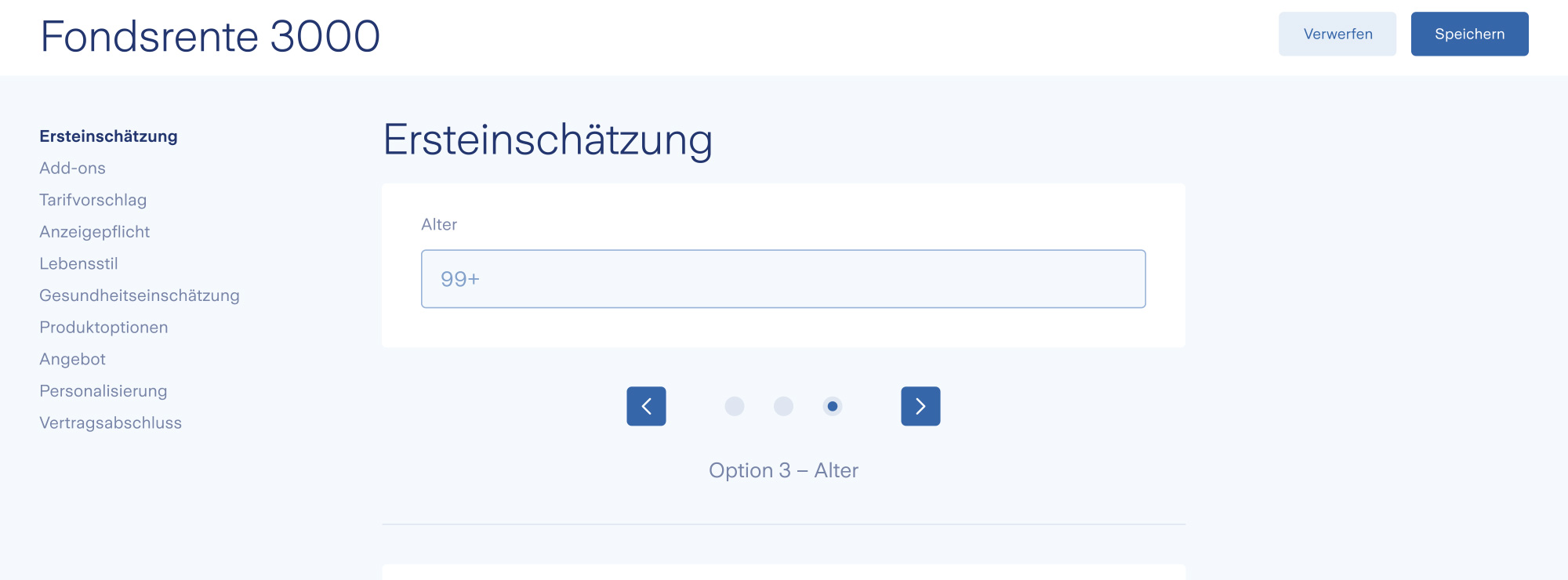A leading software corporation won a pitch to design a completely new IT system for a global insurance company. My team designed the user interfaces and developed a concept for a combined insurance funnel for brokers and consumers.
Project Context
The client’s current system was over 40 years old and did not meet the requirements of a modern user experience. Due to the complexity of the system and its connection to multiple technical solutions, the client has been hesitant to start a complete redesign, instead choosing to patch up various features only when they failed. As a result, the system has become inconsistent, error-prone, and expensive to maintain and train users. Creating new insurance products always relied on IT services, which took several months to complete. This made it difficult to quickly respond to changing requirements, shifting markets, and advanced expectations of customers. The client desired a modern system that was easy to navigate and interact with, while also offering flexibility and future-proof adaptability.
We are waiting 8 months for new features.
Client Quote
The Challenges
This assignment posed challenges on both the project management and product development side. Our obstacles included a system constrained by technological and legal requirements, a mindset that was entrenched in a comfort zone, and a project with a demanding deadline that spanned four teams in three different companies.
The Insurance World
The limited time frame did not allow for ample ethnographic research to gain deeper insights into the insurance space. We opted to conduct a series of focused workshop sessions with a domain expert instead. This was the most efficient way to get us up to speed quickly and understand the challenges of the industry.
Our most important learnings were:
- The user journey has multiple entry and exit points and is often paused.
- The ‘shared screen’ scenario is the most common for insurance funnels, where brokers and customers navigate the funnel together.
- Legal requirements dictate some information that needs to be collected, but most insurance companies define many more questions based on their own processes
After conducting a thorough competitor review, we discovered that while the customer-facing interfaces had already undergone improvements, the internal systems remained overwhelmed with an excess of features meant to cater to every potential use case.



Furthermore, we developed three proto-personas as a means of validating our ideas through a cognitive walkthrough. These proto-personas included the Insurance Customer, Insurance Broker, and Product Administrator.
Setting Goals
All the insight we gained from the domain expert and our own research helped us to set the two main goals that our solution had to achieve:
1. Creating a holistic system for all users
Since the user journeys of our personas were so entwined with several entry and exit points, pauses to gather new information from different tools or services and frequent changes between collaboration and independent work, it made most sense to design one interface that could take several states depending on who uses it in which scenario.
2. Creating a barebone insurance funnel
We also wanted to redesign the insurance funnel to reflect the user needs and expectations instead of mirroring the company’s processes. This required careful observation of all legal requirements as well as a good understanding of the client’s internal processes. The domain expert was a valuable source of information to gain this insight and validate our ideas.
Product Strategy
The product roadmap was set up for almost 2 years but we had only two weeks to present a product prototype to the client that would demonstrate the key parts of the product strategy. We identified two focus areas where we could have the most impact in the short time we had
- Insurance Funnel, to create a better experience for all users
- Product Manager, to showcase how the holistic system could be adapted
Presentation
We presented the solutions we developed to the client through a series of half-day workshops. Each workshop focused on a different topic, with the overall goal of enhancing the client’s UX maturity level and promoting agile development. We used our solutions to demonstrate various concepts and how our designs would support those topics. The series began with a session on UCD, followed by topics such as design systems, frontend- and backend development, and architecture.
The Solution
We designed a minimalistic insurance funnel by rigorously questioning the status quo. We were able to provide a quote on the first step of the funnel giving the users the information they came for. We moved as much administration towards the end of the funnel as possible to reduce the drop-out rate. Too many funnels ask users to jump through hoops before proving their worth.
Design System
The UI had to be flexible enough to allow administrators to re-arrange the interface for new products. We achieved this by creating a structured interface with several layers. The innermost layer was a card. Each card had a dedicated purpose but was available -and extendable- in different flavours.
For example: to capture a customer’s age you could choose a date picker, a text field, or a combination of DOB and gender (to calculate different retirement ages). Strategies like this enabled us to set up a solid design system that would allow for expansion as well as adaptation by product admins.
My Contributions
It was a challenging project with complex requirements, numerous stakeholders, and a tight deadline. With my leadership and guidance, my design team was able to rise to the occasion.
I spearheaded the requirements gathering, working closely with the experts to identify opportunities and limitations. I also provided creative direction and shaped the product vision, ensuring that we were aligned with the client’s objectives and mission.
Throughout the project, I organised stakeholder collaboration, establishing a streamlined process that ensured all parties were informed and had input. I also developed a documentation structure that allowed for easy accessibility and transparency for all team members.
I educated the client about user-centered design and design systems, showing them the benefits of these principles and how they could be implemented to create a user-friendly product. I presented our solutions to the client, receiving positive feedback on the innovative design and seamless user experience.
Finally, I developed a product development roadmap for the design team, outlining our plan for future iterations and improvements. Overall, my leadership and contributions were critical to the project’s success, and I am proud of the product that we delivered in such a short time.
Notes & References
– Device image via MidJourney
– UI Design by Vladislav Belousov















